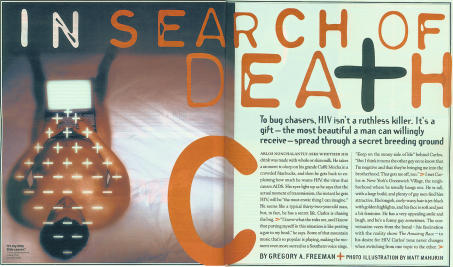The US glossy magazine Rolling Stone is best known for its coverage of the latest music and movies. But recently it tried its hand at a little HIV epidemiology, and found itself accused of sensationalism and virulent homophobia.
In a feature called “In search of death,” published in its February issue, the magazine suggested that a new craze is sweeping America. Thousands of gay men each year are apparently seeking out HIV positive partners in order to become infected. These men are known as “bug chasers.” The men who give them the virus are “gift givers.”
This was not the first story about bug chasing—in September 1997, for example, Newsweek ran a feature entitled “A deadly dance” that discussed the phenomenon. What was shocking about the Rolling Stone article was its assertion that an astonishing 25% of all new HIV infections in gay men was caused by bug chasing.
The article profiled one bug chaser called Carlos (a pseudonym), a 32 year old gay man living in New York, who has an intense desire to become infected with HIV. The moment of transmission, said Carlos, will be, “the most erotic thing I can imagine.”
Becoming HIV positive, said the article, will initiate Carlos into “a brotherhood.” He will apparently become part of a flourishing community of bug chasers and gift givers who meet online in chat rooms dedicated to “barebacking” (having unprotected anal sex).
“Carlos,” said the piece, “has been chasing the bug for more than a year in a topsy-turvy world in which every convention about HIV is turned upside down. The virus isn't horrible and fearsome, it's beautiful and sexy.”
If Rolling Stone has its figures correct—that a quarter of new HIV infections are from bug chasing—Carlos is just one of many thousands of bug chasers in America. It is this assertion that has infuriated members of the US gay community, who fear that conservative groups will use the article to attack gay men for reckless behaviour.
Larry Hanbrook, from San Francisco's department of public health, told the Bay Area Reporter (30 January), a weekly gay newspaper, that “almost everyone I know is angry because the information is spurious, is unfounded, and is untrue.”
The Gay and Lesbian Alliance Against Defamation (www.glaad.org) called the piece “grossly sensationalistic reporting” that “sends a dangerous, inaccurate message that is already being exploited by the anti-gay right.”
Rolling Stone says that its data came from an interview with Bob Cabaj, director of behavioral health services at San Francisco's department of public health. But immediately after the piece was published, Cabaj asserted that he never mentioned any figures on the prevalence of bug chasing. In a letter to Rolling Stone, which was forwarded to the BMJ, Cabaj wrote: “I did not have data, as I explained to the [Rolling Stone] author, but was saying it was probably more common than people wanted to think.”
And in an interview with Newsweek (23 January), Cabaj distanced himself even further from the widely quoted prevalence data: “I never said that [it was 25%]. And when the fact checker called me and asked me if I said that, I said no. I said no. This is unbelievable.”
The US media also questioned the validity of Rolling Stone's data. The Washington Times (24 January) quoted Jessica Frikey of the Centers for Disease Control and Prevention as saying, “No studies have been done to see how many ‘bug chasers’ there are.”
In an editorial on Salon.com (24 January), the respected columnist Andrew Sullivan said that the Rolling Stone piece was “riddled with unbelievably shoddy work.” He gave one striking example—the piece had said that there were 40 000 new HIV infections each year in the US, so around 10 000 each year were caused by bug chasing. But the 40 000 figure, said Sullivan, refers to all HIV infections per year, of which 42% are in men who have sex with men. “So even if you buy the bizarre 25% figure,” said Sullivan, “you don't end up with 10 000, you end up with 4200.”
So why did Rolling Stone suggest that the phenomenon was so widespread? Perhaps, suggested UK Sunday newspaper the Observer (26 January), because its new British editor, Ed Needham, wanted to create a stir so that people would start noticing the magazine. “Such a sensational impact,” said the paper, “was exactly what was demanded from colleagues by Needham when he took over last year.” 
Rolling Stone's sensationalism may have helped to sell more mags, but it has taken the world back two decades to a time when the media characterised gay men as disease-ridden perverts, and HIV as a “gay plague.” The magazine's branding of gay men as bug chasers and gift givers, said Andrew Sullivan, suggests that they are “heading toward another selfish, disgusting and sickening AIDS Armageddon.”
And by stirring up hysteria about what may be an extremely rare phenomenon, Rolling Stone missed a far more important story—namely, that health professionals are failing to get the prevention message across to people both within and beyond the gay community.
With perfect timing, a new documentary called The Gift, which puts the issue of bug chasing within the context of a worldwide pandemic that shows little sign of slowing down, premiered last week at the Berlin International Film Festival. The film's maker, Louise Hogarth, told the Bay Area Reporter (30 January), “We need to change the [prevention] messages.” She added: “The issue is the failure of prevention. What we are doing now is not working.”
Figure.
Critics have called the Rolling Stone article “grossly sensationalistic reporting”



